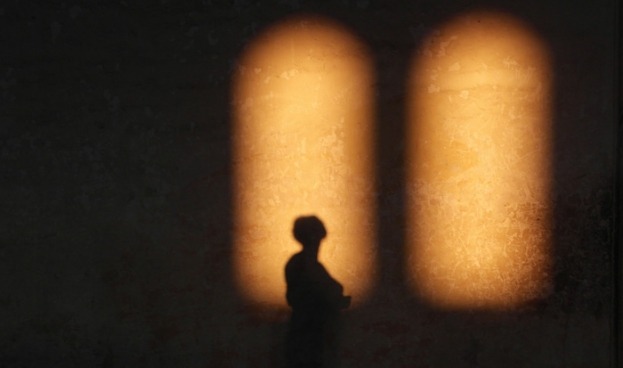Dark Shadows
When I was thirteen, my friend Debra and I would walk to her house after school, plop down on the floor in front of the TV and glue our eyes on the spooky soap opera Dark Shadows.
We were so engrossed by the evil vampire, Barnabas Collins, we hardly paid attention to the snacks Debra's mother had ready for us. After a day of muddling through math problems and sentence diagrams, nothing less than this delicious dish of melodrama — now considered a cult classic — could suffice. In my parents' childhood, evil "lurked" on the radio show The Shadow, which provided the same devilish entertainment. I knew it was all fantasy and fun. Not until I grew older did it dawn on me that the shadow was real. It may not drink our blood and cast curses, but as Carl Jung reminds us, "everyone carries a shadow." And it features prominently in the spiritual journey. That is why, in the Alphabet of Spiritual Literacy, "S" is for shadow.
As a youth, I was frightened by my own shadow-side. But through dialogue with compassionate spiritual leaders, I finally understood that this mysterious, disturbing, and often confounding part of myself need not be feared like a vampire. But it does need tending — oh, yes! The shadow often cries for attention in the most regretful ways: an outburst of irrational anger, unbidden jealousies, greedy hoarding, selfish decisions, or that hurtful remark you never meant to say and wonder, "where did that come from?" Maybe it appears as irrational fear or crippling anxiety or addictive behaviors that we try to hide. Such red flags remind us that our shadow needs our attention. For the spiritual pilgrim, such confounding matters call for serious soul work, forgiveness, wisdom, and sometimes outside help. But above all, it calls for compassionate self-awareness.
Weaving the Shadow
In my own tradition, Lent is the season for facing our shadow through prayer, fasting, and ritual. The Lenten journey begins with ashes but ends with Easter gladness — an inner Spring-like rebirth alongside budding trees and re-awakened gardens. But you do not have to be religious to understand the need for tending to the weeds in our inner gardens. Of course, the weeds-in-the-garden metaphor breaks down quickly as we do not want to discard or "kill" anything within us, but rather heal and transform. So, Instead, think of soul work as weaving a beautiful blanket or tapestry.
We are constantly weaving fresh moments of becoming. The pattern evolves; our past work never constitutes the final piece. Unfolding in companionship with God, the fabric of the soul is woven from many threads of experience. Some come from heaven, some from our past, some from our shadow. Some threads may seem off color, incongruous — even jarring. Yet, by skillfully weaving these mismatched threads into the larger whole through forgiveness and compassionate self-awareness, the emerging design deepens into fresh patterns of intense harmony.
And so, in this way, caring for your shadow intensifies and strengthens the beauty of your soul. But if the shadow is ignored or denied, it can take on a life of its own, overtaking an individual or a society. At some point, the thread snaps and life unravels. The undoing happens quickly, especially when the shadow takes to social media. There it can grow very dark and multiply like rabbits (no offense to rabbits). Yes, the shadow needs our care or it becomes quite dangerous. Jung says not only that "everyone carries a shadow," but that "the less it is embodied in the individual's conscious life, the blacker and denser it is."
Sitting with the Shadow
I have discovered that the best way to weave my own shadow-side into a wider beauty is to pay attention, listen deeply, and offer my shadow all the compassion and wisdom my better self has to offer. The same goes for dealing with the untended shadows of others. For the shadow within or without, the remedy always comes from the same place: that divine reservoir of compassion that also resides in each of us. For me, the spiritual discipline of journaling is the needle and thread of my inner work. Through writing, awareness begins to surface, and a dialogue with my wounded self can finally restore my best self.
While it is fun to be afraid of ghost stories and vampires, let us never fear our shadow in that way. Our shadow-side is part of our humanity, albeit the more primitive, unpleasant, and difficult side. With courage, we can look deeply into the dark side of our being — not to judge and condemn — but to understand, to suffer with, and to love back into the wide, rich tapestry of our being.

 Weaving the Shadow: A Lenten Reflection
Weaving the Shadow: A Lenten Reflection